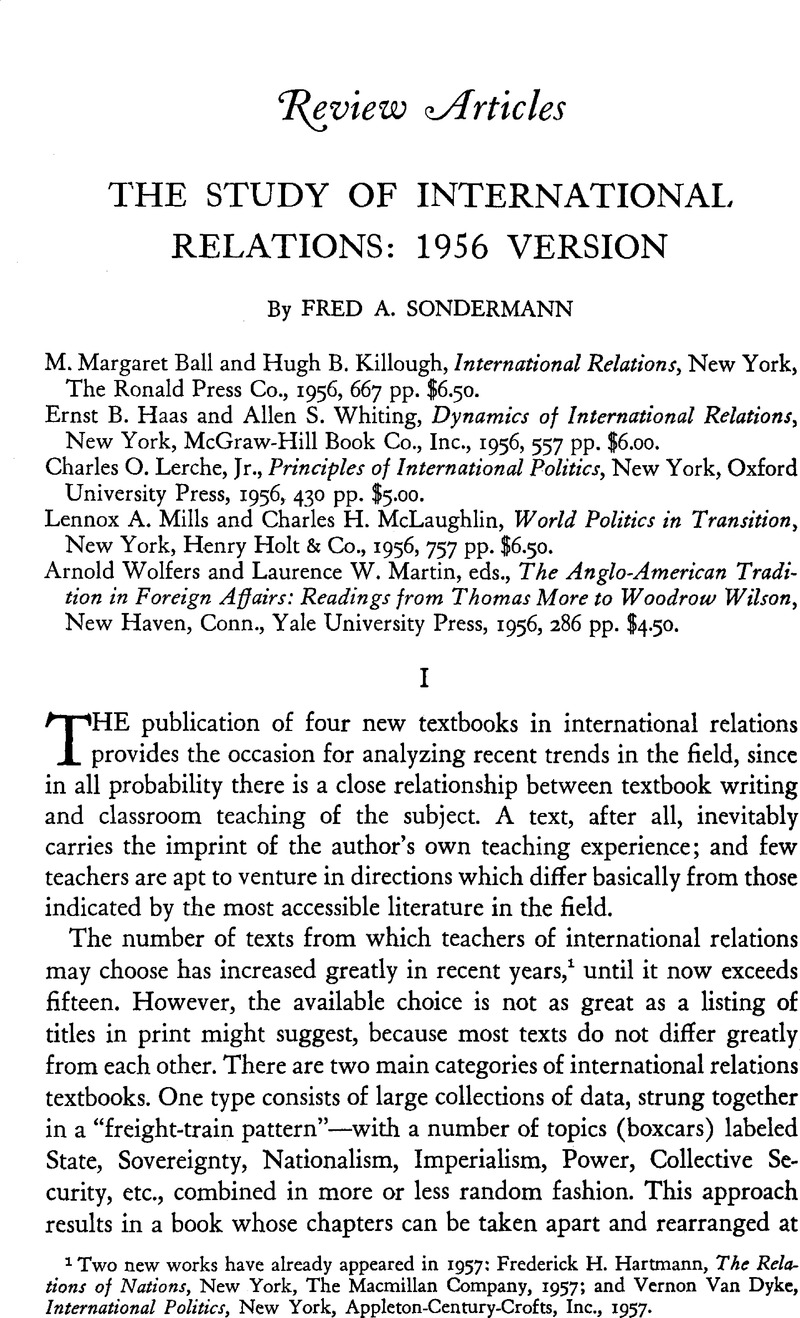Article contents
The Study of International Relations: 1956 Version
Published online by Cambridge University Press: 18 July 2011
Abstract

- Type
- Review Articles
- Information
- Copyright
- Copyright © Trustees of Princeton University 1957
References
1 Two new works have already appeared in 1957: Hartmann, Frederick H., The Relations of Nations, New York, The Macmillan Company, 1957Google Scholar; and Dyke, Vernon Van, International Politics, New York, Appleton-Century-Crofts, Inc., 1957.Google Scholar
2 Morgenthau, Hans J., Politics Among Nations: The Struggle for Power and Peace, New York, Alfred A. Knopf, 1948.Google Scholar (A revised and enlarged edition of this work was published in 1954.)
3 A publisher's advertisement for this text states that “… the book informs the student but avoids forcing any interpretation or judgment upon him. It consistently encourages him to … draw his own conclusions.”
4 Wright, Quincy, The Study of International Relations, New York, Appleton-Century-Crofts, Inc., 1955, p. 7.Google Scholar
5 Two surveys in this field which merit the attention of international relations specialists are May, Mark A., A Social Psychology of War and Peace, New Haven, Conn., Yale University Press, 1943Google Scholar; and Pear, T. H., ed., Psychological Factors of Peace and War, New York, The Philosophical Library, 1950.Google Scholar
6 To cite a concrete example: Haas and Whiting identify various factors which keep international violence from breaking out more frequently. These include ideological restraints, institutional restraints, and the unwillingness of domestic interest groups to resort to force because of fear that violence might be disadvantageous to them. “The restraints are self-imposed and self-administered; they do not originate from some outside power” (pp. 49–50). But is the outbreak of violence not also restrained by the relative capacities of participants and, even more to the point, by the operation of the balance-of-power process in international relations? (This process, incidentally, is neglected by several authors for obvious reasons: it does not fit very well into an analytic scheme which centers on state/group behavior.) Granted that the balance of power process does not operate autonomously, without being invoked by some group or groups. Might it not be argued, however, that its use is an inherent consequence of the real “dynamics” of international relations and of the nature of the environment in which these relations take place?
7 See, for example, a review of an earlier international relations text in this journal: Harold Sprout, “In Defense of Diplomacy,” 1, No. 3 (April 1949), pp. 404–13. Professor Sprout's “tentative and fallible notions of the scope and structure of the field” of international relations included (in addition to points on objectives of foreign policy, motivations of statesmen, tools and techniques of statecraft, state capabilities, and regulatory mechanisms) an item on “Interstate relationships: What relationships arise from the simultaneous and often antagonistic efforts of states to attain their foreign policy objectives?” It would seem that this point has frequently been neglected.
8 Dunn, Frederick S., in “The Scope of International Relations,” World Politics, 1, No. 1 (October 1948), pp. 142–46CrossRefGoogle Scholar, points out that knowledge of international relations is not merely the extension of knowledge of domestic relations to a wider field but has important unique elements due to the nature of the environment in which international relationships take place.
9 Wallas, Graham, Human Nature in Politics, New York, Alfred A. Knopf, 1921, p.38.Google Scholar
10 The new texts by Professors Hartmann and Van Dyke (see note 1) organize their subject within theoretic schemes and thus lend themselves to comparative analysis with the books by Professors Lerche, Morgenthau, Haas-Whiting, and others.
- 6
- Cited by


